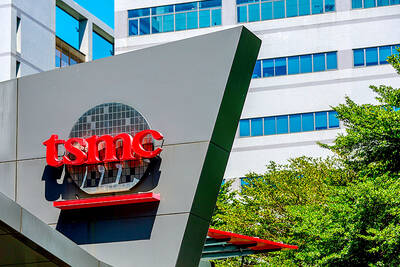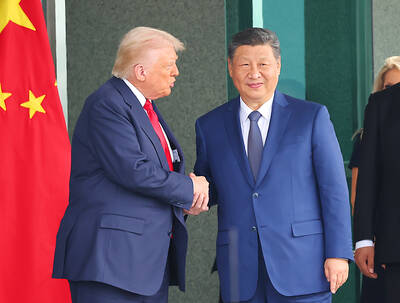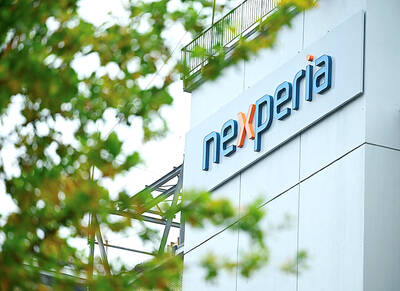Japanese Economy Minister Seiji Maehara said Japan needs more monetary easing and policy efforts to encourage growth as the government prepares for election against an opposition that has stronger public support.
The government plans to inject about ¥200 billion (US$2.5 billion) into the economy, Maehara said on a Fuji Television program, without giving details on the source of those funds.
Spending this fiscal year includes ¥910 billion of stimulus programs requiring parliament’s approval, ¥400 billion for earthquake recovery and a further ¥347.8 billion, he said.
“There are fiscal-easing moves worldwide, but on a monetary basis Japan is falling short,” Maehara said yesterday.
While “easing is not a panacea,” without that and policy moves “Japan’s sovereign credit rating may face a downgrade,” he said.
The government on Oct. 12 issued a downgraded assessment of Japan’s economy for a third month, the longest streak since the 2009 global recession, as gains in the yen and slowing overseas demand hurt exporters.
Japanese Prime Minister Yoshihiko Noda, who last week ordered his Cabinet to draw up economic stimulus measures by next month, failed to reach agreement with the two largest opposition parties on passing legislation needed to fund spending amid a standoff over the timing of a general election.
Noda met on Friday with Japan’s Liberal Democratic Party leader Shinzo Abe and New Komeito head Natsuo Yamaguchi.
The two parties supported legislation passed in August doubling the 5 percent sales tax in return for Noda’s pledge to call elections “soon,” and are blocking authorization of deficit-financing bonds until the prime minister follows through.
“It seems to me that ‘soon’ doesn’t mean next year,” Maehara said, suggesting that Noda may call the election as early as this year. “Prime Minister Noda is a person who honors his promises.”
Noda is Japan’s sixth prime minister since 2006, and the third for the Democratic Party of Japan since it defeated the Liberal Democratic Party (LPD) in 2009 after the LDP’s half-century domination of government.
He has been unable to reverse more than a decade of deflation and his biggest legislative achievement was a sales tax increase that risks damping consumption.
Noda’s approval rating was 34 percent in a Yomiuri Shimbun newspaper poll published on Oct. 3, compared with 65 percent when he took office 13 months ago.
Support for his DPJ was at 18 percent, while that of the LDP was 28 percent.
Almost 45 percent had no party preference.
Noda is not legally obliged to dissolve the lower house of parliament and call an election until August next year.
Bank of Japan Governor Masaaki Shirakawa’s board held off from easing monetary policy at a two-day meeting ended on Oct. 5 even as it downgraded its assessment of the economy.
The Bank of Japan has room to ease more, IMF Deputy Managing Director Naoyuki Shinohara said on Oct. 9, adding to calls from lawmakers for additional action by the central bank.
Maehara said this month that buying foreign bonds is an option for monetary stimulus.

RUN IT BACK: A succesful first project working with hyperscalers to design chips encouraged MediaTek to start a second project, aiming to hit stride in 2028 MediaTek Inc (聯發科), the world’s biggest smartphone chip supplier, yesterday said it is engaging a second hyperscaler to help design artificial intelligence (AI) accelerators used in data centers following a similar project expected to generate revenue streams soon. The first AI accelerator project is to bring in US$1 billion revenue next year and several billion US dollars more in 2027, MediaTek chief executive officer Rick Tsai (蔡力行) told a virtual investor conference yesterday. The second AI accelerator project is expected to contribute to revenue beginning in 2028, Tsai said. MediaTek yesterday raised its revenue forecast for the global AI accelerator used

Taiwan Semiconductor Manufacturing Co (TSMC, 台積電) has secured three construction permits for its plan to build a state-of-the-art A14 wafer fab in Taichung, and is likely to start construction soon, the Central Taiwan Science Park Bureau said yesterday. Speaking with CNA, Wang Chun-chieh (王俊傑), deputy director general of the science park bureau, said the world’s largest contract chipmaker has received three construction permits — one to build a fab to roll out sophisticated chips, another to build a central utility plant to provide water and electricity for the facility and the other to build three office buildings. With the three permits, TSMC

TEMPORARY TRUCE: China has made concessions to ease rare earth trade controls, among others, while Washington holds fire on a 100% tariff on all Chinese goods China is effectively suspending implementation of additional export controls on rare earth metals and terminating investigations targeting US companies in the semiconductor supply chain, the White House announced. The White House on Saturday issued a fact sheet outlining some details of the trade pact agreed to earlier in the week by US President Donald Trump and Chinese President Xi Jinping (習近平) that aimed to ease tensions between the world’s two largest economies. Under the deal, China is to issue general licenses valid for exports of rare earths, gallium, germanium, antimony and graphite “for the benefit of US end users and their suppliers

Dutch chipmaker Nexperia BV’s China unit yesterday said that it had established sufficient inventories of finished goods and works-in-progress, and that its supply chain remained secure and stable after its parent halted wafer supplies. The Dutch company suspended supplies of wafers to its Chinese assembly plant a week ago, calling it “a direct consequence of the local management’s recent failure to comply with the agreed contractual payment terms,” Reuters reported on Friday last week. Its China unit called Nexperia’s suspension “unilateral” and “extremely irresponsible,” adding that the Dutch parent’s claim about contractual payment was “misleading and highly deceptive,” according to a statement